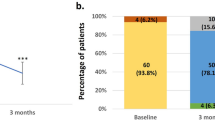Abstract
The reduction of pain by two antidepressants, clomipramine and mianserin, was, in this study on 253 patients with chronic idiopathic pain syndrome, found to be not better than a placebo when all patients were compared independently of the classification of pain. The improvement rate was around 40% after 6 weeks of treatment when using a 50% or better reduction in pain level. However, in patients who fulfilled a checklist definition of minor to major depression (30% of the total patient material) clomipramine was superior to mianserin and placebo with an improvement rate of 75% after 6 weeks. Using pain curves over time as outcome measure in the various clinical pain categories it was found that both mianserin and clomipramine seemed superior to placebo in patients with tension headache, but in patients with low back pain syndrome placebo was superior to the two antidepressants. No difference among the three treatments was found in patients with burning mouth syndrome or in patients with abdominal pain. These differences underline the importance of studying specific pain syndromes rather than composite groups of patients with idiopathic pain. The clinical significance of these pain curves needs further placebo controlled investigations.
Similar content being viewed by others
References
American Psychiatric Association (1980) Diagnostic and Statistical Manual of mental disorders, 3rd edn (DSM-III). American Psychiatric Association, Washington DC
Bech P (1987) Quality of life in psychosomatic research. Psychopathology 20:70–87
Bech P (1988) Rating scales for mood disorders: applicability, consistency and construct validity. Acta Psychiatr Scand [Suppl] 345:45–55
Bech P, Rafaelsen OJ (1980) The use of rating scales exemplified by a comparison of the Hamilton and the Bech-Rafaelsen melancholia scale. Acta Psychiatr Scand 62 [Suppl] 285:128–131
Bech P, Gram LF, Dein E, Jacobsen O, Vitger J, Bolwig TG (1975) Quantitative rating of depressive states. Acta Psychiatr Scand 51:161–170
Bech P, Gjerris A, Andersen J (1983) The Melancholia Scale and the Newcastle Scales. Item combinations and inter-observer reliability. Br J Psychiatry 143:48–63
Bech P, Kastrup M, Rafaelsen OJ (1986a) Mini-compendium of rating scales for states of anxiety, depression, mania, schizophrenia with corresponding DSM-III syndroms (1986a) Acta Psychiatr Scand 73 [Suppl] 326:7–37
Bech P, Jørgensen B, Jeppesen K, Loldrup D, Vanggaard T (1986b) Personality in depression: concordance between clinical assessment and questionnaires. Acta Psychiatr Scand 74:263–268
Bech P, Hjortsø S, Lund K, Vilmar T, Kastrup M (1987) An integration of DSM-III and ICD-8 by global severity assessments for measuring multidimensional outcomes in general hospital psychiatry. Acta Psychiatr Scand 75:297–306
Beck AT, Ward CH, Mendelson M, Mock J, Erbaugh J (1961) An inventory for measuring depression Arch Gen Psychiatry 4:561–571
Carney MWP, Roth M, Garside RF (1965) The diagnosis of depressive syndromes and predictions of ECT response. Br J Psychiatry 111:659–74
Eberhard G, von Knorring L, Nilsson HL, Lundquist U, Bjøvling G, Linder H, Sværd KO, Tysk L (1988) A double blind randomized study of clomipramine versus maprotiline in patients with ideopathic pain syndromes. Neuropsychobiology (in press)
Eysenck HG, Eysenck SBG (1975) Manual of the Eysench Personality Questionnaire. Hodder and Stoughton, London
Goldberg D (1972) The detection of psychiatric illness by questionnaire. Oxford University Press, Oxford
Guy W (1976) Early clinical drug evaluation (ECDEV) assessment manual for psychopharmalogy, publication no 76-338. National Institute of Mental Health, Rockwille
Hamilton M (1959) The assessment of anxiety states by rating. Br J Med Psychol 32:50–55
Hansen HJ (1988) Double-blind comparative study on the effect on salivation after single doses of levoproteline, amtriptyline, maprotiline and placebo. Ciba-Geigy Protocol No. LE/GDK 01
Hansen HJ, Glenert U, Loldrup D, Bech P (1986) Correlation between dry mouth feeling and salivatory secretion during antidepressant treatment. J Dent Res 65:434
Jørgensen B, Nørrelund N, Bech P, Jakobsen K (1984) Smerter og depressive symptomer i almen praksis. Ugeskr F Laeger 146:2868–2872
von Knorring L (1975) The experiences of pain in depressed patients. Neuropsychobiology 1:155–165
Krishman KRR, France RD, Pelton S, McCann VD, Davidson J, Urban BJ (1985) Chronic pain and depression. Pain 22:279–287
Langer SZ, Moret C, Raisman R, Dubocovich ML, Bailey M (1980) High-affinity 3H-imipramine binding in rat Hypothalamus: association with uptake of serotonin but not of norepinephrine. Science 210:1133–1135
Maier W, Philipp M (1985) Comparative analysis of observer depression scales. Acta Psychiatr Scand 72:239–245
Mellerup ET, Bech P, Hansen HJ, Langemark M, Loldrup D, Plenge P (1988) Platelet 3H-imipramine binding in psychogenic pain disorders. Psychiatry Res 26:149–156
Pilowsky I, Chapmann CD, Bonica JJ (1977) Pain, depression and illness behavior in a pain clinic population. Pain 4:183–192
Pocock SJ (1983) Clinical trials: a practical approach. Wiley, Chichester
Quitkin FM, Rabkin JG, Ross D, McGrath PJ (1984) Duration of antidepressant drug treatment. Arch Gen Psychiatry 41:238–245
Siegel S (1956) Non-parametric statistics. McGraw Hill, New York
Smith A, Tranganza E, Hanison G (1969) Studies on the effectiveness of antidepressant drugs. Psychopharmacol Bull [Suppl] 1–53
Spielberger CD, Gorsuch RL, Lushene RE (1970) STAI manual for the State-Trait Anxiety Inventory. Consulting Psychologists Press, Palo Alto
Sternbach RA (1974) Pain patients. Traits and treatment. Academic Press, London
Walsh TD (1983) Antidepressant in chronic pain. Clin Neuropharmacol 6:271–295
Ward NG, Bloom VL, Friedel RO (1979) The effectiveness of tricyclic antidepressants in the treatment of coexisting pain and depression. Pain 7:331–341
Author information
Authors and Affiliations
Rights and permissions
About this article
Cite this article
Loldrup, D., Langemark, M., Hansen, H.J. et al. Clomipramine and mianserin in chronic idiopathic pain syndrome. Psychopharmacology 99, 1–7 (1989). https://doi.org/10.1007/BF00634443
Received:
Accepted:
Issue Date:
DOI: https://doi.org/10.1007/BF00634443




